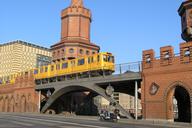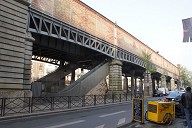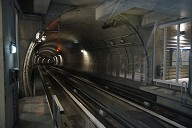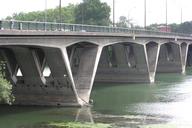Competition win in Hamburg: HafenCity continues to grow
The result of the realization competition for the southern extension of the U4 to Grasbrook was recently announced. The team of sbp, gmp and WTM won.
Media
The team of schlaich bergermann partner (sbp), von Gerkan, Marg and Partners Architects (gmp) and WTM Engineers hove won the two-stage competition for the extension of the U4 subway line to the new Grasbrook district in Hamburg.
The leap across the Elbe arrives with three new structures: extension of the U4 in Hamburg will open up Grasbrook and Veddel
The nearly 1,000-meter-long infrastructure project consists of a total of three sections: a railway bridge over the Elbe, a viaduct on the land side, and a two-story bridge with a suspended subway station at Moldauhafen that floats above the water. Due to the unity of the design, the proposal convinced the jury with its seamless transitions between the three sections and the integrated connection of the U4 line.
At the beginning of 2022, Hamburger Hochbahn AG invited eight pre-qualified teams to participate in the interdisciplinary design competition for the extension of the U4 from Elbbrücken to Grasbrook. Of the total of eight entries from international planning consortia, the selection committee decided in favor of the joint design by sbp, gmp and WTM after the second stage with only three participants.
The extension of the U4 line across the Elbe links the new Grasbrook district on the southern bank of the Norderelbe, which is currently under development, to Hamburg's HafenCity. This means that the long-planned "leap across the Elbe" is now a reality. The new Moldauhafen stop will initially be designed as the terminus of the U4line, with an extension to Wilhelmsburg already in sight.
In order to not visually disrupt the historic Freeport Elbe bridges (Freihafenelbbrücken) in the first section, a lightweight and transparent network arch with dynamically flat steel arches and intersecting carbon hangers was chosen for the new Elbe bridge - a unique and innovative solution in the field of arch bridge construction. After crossing the Elbe, the arches merge into the V-shaped steel supports of the elevated viaduct, which stand in the direction of travel. The distinctive V-shaped supports continue in a loose rhythm to the Moldauhafen subway station. There, the rhythm of the supports condenses into a bridge structure as a truss from the two traffic levels. The frame structure for the station roof develops logically from this motif. Hamburg's first subway station to float above the water is characterized by a semi-transparent photovoltaic glass façade. At night, a warm-toned lighting concept that is self-sufficient thanks to the energy façade provides travelers with a welcoming orientation.
Sven Plieninger, board member of sbp se, comments on the win as an important contribution to the neighborhood development of Hamburg's HafenCity:
"We are very pleased that we hove now also won the extension of the U4 as a continuation of the Elbbrücken subway and commuter rail station already planned with gmp. With our design, we are not only shaping the cityscape of the growing HafenCity, but with the carbon network arch and the energy façade, we are a/so setting an important example in terms of innovation and sustainability in the new Grasbrook district."
Nikolaus Goetze, partner at gmp:
"It is a great challenge to be able to realize the leap across the Elbe from the Elbbrücken bridges to Moldauhafen together with sbp and WTM in one piece with the continuation of the U4. At this central networking point of Ham burg 's urban silhouette, we feel equally committed to tradition and innovation. The new Moldauhafen station wil1 be - figuratively speaking - the first station in Hamburg to float entirely above the water. As the second station on the U4 fine to be located above ground, it also clearly shows its kinship with the Elbbrücken subway station."
Gerhard Zehetmaier, partner of WTM Engineeers:
"The development of a future-oriented mobility for Hamburg is very elose to our hearts. Therefore, we are pleased to be part of the U4's leap across the Elbe. Together with sbp and gmp, we want to create a milestone for sustainable and user-friendly infrastructure in a growing metropolis: with creative and innovative ideas - and with a lot of heart and soul."
U4 Elbe Bridge
On the first section of the infrastructure project, the historic Freeport Elbe bridges from 1926 domínate the current surroundings. To highlight their visual and historical significance, the team designed the new network arch bridge structure to be as slender as possible, using intersecting carbon hangers to minimize its visual impact as it crosses the Elbe.
The spans and the position of the piers are adapted to the Freeport Elbe Bridge behind - comparable to the annual rings of a tree - the new U4 Elbe Bridge lines up without obscuring the levels behind. The result is three almost identical, optimized arches with an elegant, low arch line that reduce resource consumption through the use of high strength carbon hangers.
A pedestrian and bicycle path accompanies the Elbe bridge, adjoining the western arch girder and connected to it via cantilever girders. lt is designed as a low-maintenance, welded hollow box. At the crossings to the north and south, the path is rounded out in a sweeping manner to make the traffic flow particularly smooth for cyclists.
The viewing platforms above the Elbe, which are located on the bridge piers, invite visitors to linger and offer sensational views of Hamburg and HafenCity.
Viaduct
Viaducts have a long tradition in the history of Hamburg's elevated metro and are an integral part of the cityscape. This historical significance is also reflected in the viaduct on Grasbrook.
The striking V-shaped supports under the outer main girders, in conjunction with the steel cross girders, form a harmonious yet dynamic structure. In the direction of the externally arranged main girders, the girders taper, creating an airy and light structure with sufficient daylight under the viaduct.
The V-shaped supports arranged in the direction of travel shape the public space under the viaduct, which can be used in a variety of ways as an urban activity corridor.
Moldauhafen Metro Station
From the viaduct, the subway leads onto the bridge over the Moldauhafen Harbor. The design envisages a smooth transition in that the V-shaped supports of the viaduct are more closely spaced and, together with the upper and lower edge girders, form the bridge girders (truss) over the harbor basin.
The Moldauhafen stop will be the first elevated subway stop in Hamburg to float completely above a harbor basin. lt thus allows very special views of the surrounding area and, seen in reverse, becomes the focal point of the district. As the second above-ground stop on the U4 line, the elegance and lightness it creates refer back to the first Elbbrücken stop - especially in the materiality of steel as the primary structure and the glass shell.
Nevertheless, it forms an independent character: A semi-transparent photovoltaic glass façade envelops the steel structure of A-shaped frames. The PV elements are arranged in a progression - in the roof area, the density of the PV elements is higher, and on the vertical, lateral façades, it is lower and increasingly transparent. The façade thus allows for views out to the surrounding city while also providing glare and sun protection from above. During the day, natural light illuminates the interior; at night, artificial light creates an interesting play of light with a distinct effect. The "energy façade" is representative of the start of the Grasbrook innovation district, which aims to shape the future with sustainable mobility and energy concepts.






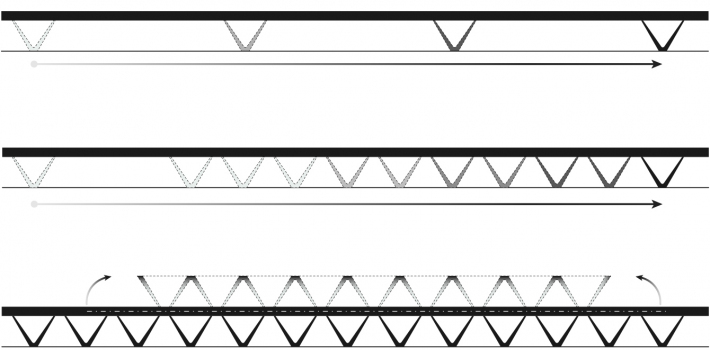
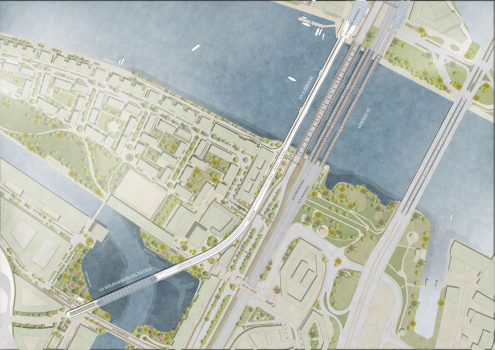

 schlaich bergermann partner
schlaich bergermann partner




